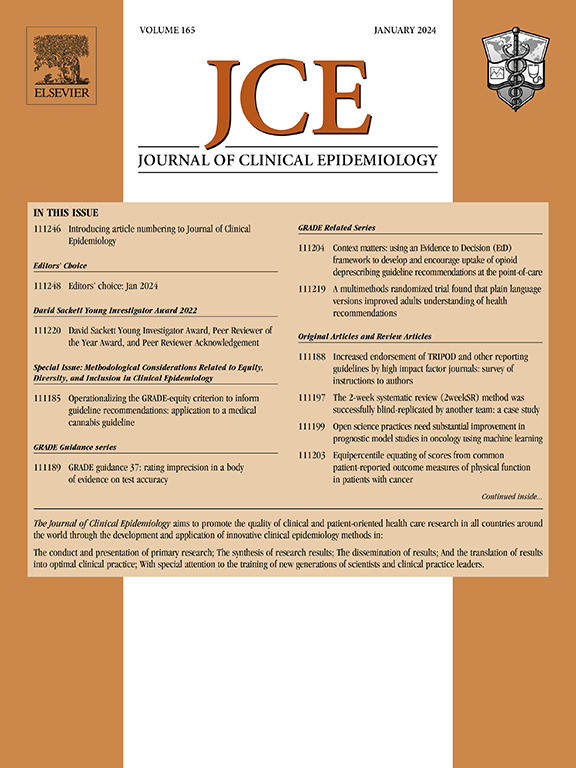证据综合类型和模式综述。
IF 5.2
2区 医学
Q1 HEALTH CARE SCIENCES & SERVICES
引用次数: 0
摘要
背景和目的:证据综合系统地汇编和分析来自多个来源的信息,以支持卫生保健决策。由于在卫生保健中需要回答许多不同类型的问题,因此出现了不同的证据合成类型。在这篇文章中,我们介绍了最常见的证据合成类型。研究设计和设置:我们讨论了不同证据合成类型和模式的目标、主要方法特征和说明性例子,借鉴了我们与证据合成分类法倡议的工作。结果:证据综合类型包括系统评价、综述性评价、定性证据综合、混合方法评价和“大局评价”(范围评价、制图评价和证据差距图)。此外,我们还重点介绍了快速和实时综述作为模式,以及它们如何应用于不同的证据合成类型。结论:临床医生和研究人员必须了解证据综合的主要类型,以选择最合适的方法来解决特定的健康相关问题。本文章由计算机程序翻译,如有差异,请以英文原文为准。
Overview of evidence synthesis types and modes
Background and Objectives
Evidence syntheses systematically compile and analyze information from multiple sources to support health-care decision-making. As many different types of questions need to be answered in health care, different evidence synthesis types have emerged. In this article, we introduce the most common types of evidence synthesis.
Study Design and Setting
We discuss the aims, key methodological features, and illustrative examples of different evidence synthesis types and modes, drawing on our work with the Evidence Synthesis Taxonomy Initiative (ESTI).
Results
Evidence synthesis types include systematic reviews, qualitative evidence syntheses, mixed methods reviews, overviews of reviews, and ‘big picture reviews’ (scoping reviews, mapping reviews, and evidence gap maps). Additionally, we focus on rapid and living reviews as modes and how they can be applied to different evidence synthesis types.
Conclusion
It is essential to understand the main types of evidence synthesis to choose the most suitable method for addressing a specific health-related question.
Plain Language Summary
Health-care decisions should be based on the best available evidence. To bring together findings from many studies, researchers use evidence synthesis-structured methods that summarize what is known on a topic. Because health questions differ, various types of evidence syntheses exist, each designed for specific needs. This article explains the aims and characteristics of the most common types of evidence synthesis: systematic reviews, overviews of reviews, qualitative evidence syntheses, mixed methods reviews, and ‘big picture reviews’ (scoping reviews, mapping reviews, and evidence gap maps). We also describe two ways evidence syntheses can be carried out: rapid reviews (done quickly to support urgent decisions) and living reviews (regularly updated as new evidence becomes available). Understanding the different approaches helps clinicians, patients, and policymakers select the right type of review for their health questions. This ensures that decisions are guided by evidence that is both reliable and appropriate for the situation.
求助全文
通过发布文献求助,成功后即可免费获取论文全文。
去求助
来源期刊

Journal of Clinical Epidemiology
医学-公共卫生、环境卫生与职业卫生
CiteScore
12.00
自引率
6.90%
发文量
320
审稿时长
44 days
期刊介绍:
The Journal of Clinical Epidemiology strives to enhance the quality of clinical and patient-oriented healthcare research by advancing and applying innovative methods in conducting, presenting, synthesizing, disseminating, and translating research results into optimal clinical practice. Special emphasis is placed on training new generations of scientists and clinical practice leaders.
 求助内容:
求助内容: 应助结果提醒方式:
应助结果提醒方式:


